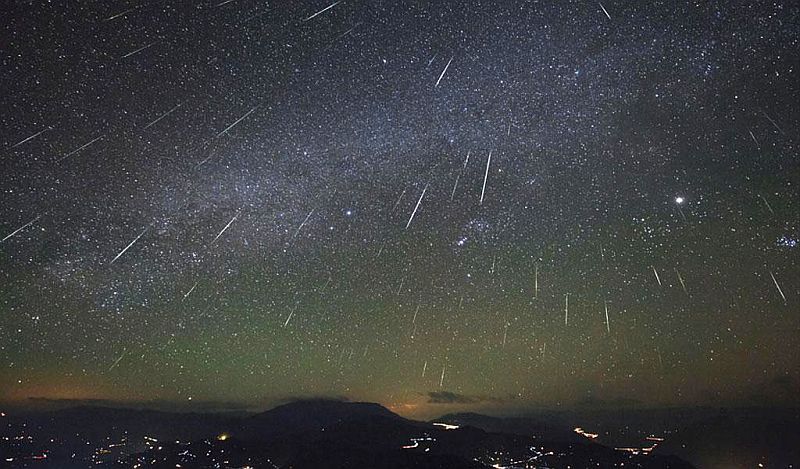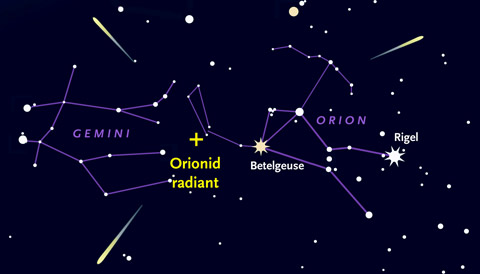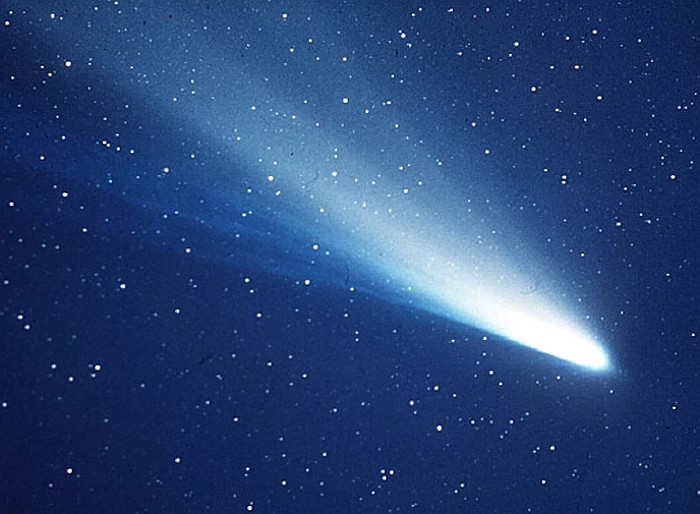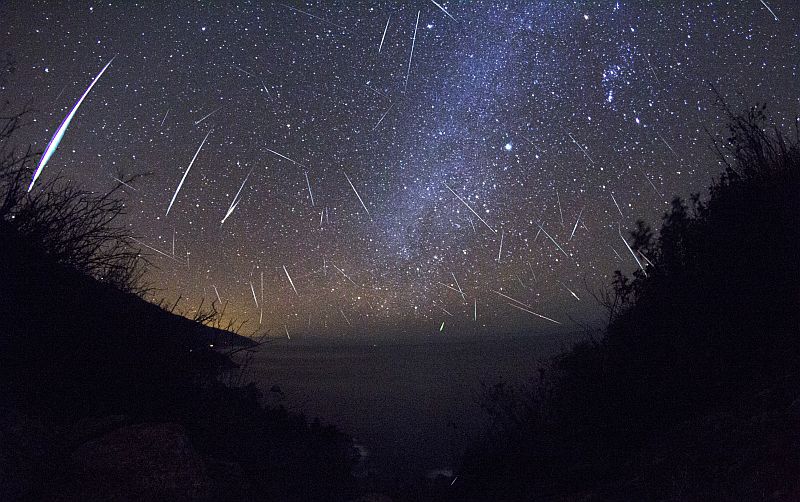Orionid Meteor Shower - 2019
- Details
- Written by AndEl

The Orionid meteor shower is set to peak on the night of Oct. 22-23, but a bright moon will disrupt viewing until shortly before dawn. The meteors that streak across the sky are some of the fastest among meteor showers, because the Earth is hitting a stream of particles almost head on.
The annual Orionids meteor shower, composed of debris from repeated passages of Comet Halley, runs from September 23 to November 27. It peaks between midnight and dawn on Tuesday, October 22. At that time the sky overhead is moving directly into the densest region of the particle field, producing 10-20 fast meteors per hour. The meteors can appear anywhere in the sky, but will be travelling away from the constellation of Orion. The waning half-illuminated moon will wash out some of the meteors.
The particles come from Comet 1P/Halley, better known as Halley's Comet. This famous comet swings by Earth every 75 to 76 years, and as the icy comet makes its way around the sun, it leaves behind a trail of comet crumbs. At certain times of the year, Earth's orbit around the sun crosses paths with the debris.
"You can see pieces of Halley's Comet during the Eta Aquarids [in May] and the Orionid meteor shower [in October and November]," Cooke told Space.com.
Orionid Meteor Shower: Leftovers of Halley's Comet
Typically, the Orionids produce about 20 meteors an hour, but in exceptional years, like 2006 and 2009, they've rivaled August's famous Perseid meteor shower. Cooke expects the shower to produce about 30 or 40 meteors an hour this year. The meteors radiate from the constellation Orion, but can be seen from anywhere in the sky.
The meteoroids from Halley’s Comet strike Earth’s atmosphere at a speed of 148,000mph, (238,000kph) incinerates in fiery flashes of light easily visible with the naked eye.
The Orionids are known for their speed and brilliance, meaning there’s a good chance this with enough patience should see several bright ‘shooting stars’ hurtling across the sky.
Halley’s Comet itself has not been visible from Earth since 1986.
How to view the show
Orionid meteors are visible from anywhere on Earth and can be seen anywhere across the sky. If you find the shape of Orion the Hunter, the meteor shower's radiant (or point of origin) will be near Orion's sword, slightly north of his left shoulder (the star Betelgeuse). But don't stare straight at this spot, Cooke said, "because meteors close to the radiant have short trails and are harder to see — so you want to look away from Orion."
As is the case with most nighttime skywatching events, light pollution can hinder your view of the Orionid meteor shower (although this year, the moon will do damage as well). If possible, get far away from city lights, which can hinder the show. Go out around 1:30 a.m. and let your eyes adjust to the dark for about 20 minutes. Bundle up against the cold if necessary. Lie back and use only your eyes to watch the sky. Binoculars and telescopes won't improve the view, because they are designed to see more stationary objects in the sky

Orionid meteors are visible from anywhere on Earth and can be seen anywhere across the sky. If you find the shape of Orion the Hunter, the meteor shower's radiant (or point of origin) will be near Orion's sword, slightly north of his left shoulder (the star Betelgeuse). But don't stare straight at this spot, Cooke said, "because meteors close to the radiant have short trails and are harder to see — so you want to look away from Orion."
As is the case with most nighttime skywatching events, light pollution can hinder your view of the Orionid meteor shower. If possible, get far away from city lights (which can hinder the show). Go out around 1:30 a.m. and let your eyes adjust to the dark for about 20 minutes. Bundle up against the cold if necessary. Lie back and use only your eyes to watch the sky. Binoculars and telescopes won't improve the view, because they are designed to see more stationary objects in the sky.
Some Orionids will appear very fast and bright, since they can whiz by at up to 148,000 mph (238,000 km/h) in relative speed. That's just six kilometers an hour slower than the Leonids, the speediest show of the year, Cooke said.
It's tempting to think that the brighter meteors represent fragments that would reach the ground, but Cooke said that isn't the case with the Orionids. These tiny comet fragments — some as small as a grain of sand — are called meteoroids. When they enter Earth's atmosphere, they become meteors. Friction from air resistance causes meteors to heat up, creating a bright, fiery trail commonly referred to as a shooting star. Most meteors disintegrate before making it to the ground. The few that do strike the Earth's surface are called meteorites. [How Often Do Meteorites Hit the Earth?]

Cometary origins
Astronomers have recorded Halley's Comet as far back as 240 B.C. but no one realized that the same comet was making multiple appearances. In 1705, then-University of Oxford professor and astronomer Edmund Halley published "Synopsis Astronomia Cometicae" ("A Synopsis of the Astronomy of Comets"), which showed the first evidence that the comet is reoccurring. By studying the historical records of a comet that appeared in 1456, 1531, 1607 and 1682, Halley calculated that it was in fact the same comet and predicted it would reappear in 1758. While Halley died before the comet's return, it did appear on schedule and was named after him.
Reports of the Orionids, however, did not first appear until 1839 when an American in Connecticut spotted the shower, Cooke said. More observations of the shower were recorded during the Civil War between 1861 and 1865. Cooke told Space.com he wasn't sure why the meteor shower was discovered so late, given that records of Halley's Comet exist for millennia.
The next perihelion (closet approach of Halley's Comet to the sun) is expected around July 2061.

Liked this article? Dive deeper into personal growth and wellness! Check out CrystalWind.ca for spiritual wisdom or explore AromaWorx.ca for natural well-being tips. Spread the positivity—share this with friends on their happiness journey!
Let’s Chat! Drop Your Thoughts Below! ![]()
Latest Articles
Dive into the Mystical World of the Crystal Wind Oracle Deck!
Get All the Enchanting Details Now!
NEW Expanded Boxed Edition!
Now with 58 Cards for Richer Wisdom!

Imagine a world of inspiration and healing, free for all—made possible by YOU!
Donate Now—Ignite the Magic at CrystalWind.ca!

Epilepsy - Finding A Cure
Your donation can make a difference!
Help us find a cure – donate now!
Unlock Your Light: Join Lightworkers Worldwide on CrystalWind.ca!
Articles: The Founders
Articles: Cosmic Neighbours
Articles: Galactic History
Follow Us!
Featured This Month
Crystals for Virgo
As the warmth of summer begins to soften into the crispness of autumn, the Sun... Read more
Sun in Virgo
An Overview of Sun Sign Characteristics for Virgo Virgo is guided by Mercur... Read more
Mabon in Modern Times: Fresh Takes on the Au…
The Mabon season begins somewhere around the 21st-22nd of September and cont... Read more
Peridot: The Healer's Stone
Peridot has been used as a Power Stone for centuries. Peridot fosters emotio... Read more
Sweet Violet
Sweet Violet Faithfulness and modesty. “I will always be true to you.” Helps... Read more
Watermelon Tourmaline
Synonym: Rainbow Tourmaline The watermelon tourmaline is a rare variety t... Read more
Mabon Magic: Ideas For Fall Decoration And R…
Welcome (almost!) to Fall! We’re turning the Great Wheel once again, toward ... Read more
Virgo Mythology
The Virgo Myth In all of constellation mythology, few legends are as misund... Read more
The Vine: September 2nd - September 29th
The Autumnal Equinox ( Alban Elfed ) Celtic Symbol : The White Swan Read more













































